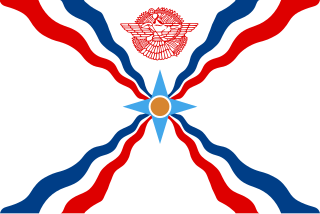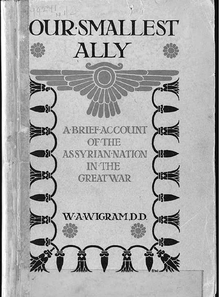
The Assyrian Church of the East (ACOE), sometimes called the Church of the East and officially known as the Holy Apostolic Catholic Assyrian Church of the East, is an Eastern Christian church that follows the traditional Christology and ecclesiology of the historical Church of the East. It belongs to the eastern branch of Syriac Christianity, and employs the Divine Liturgy of Saints Addai and Mari belonging to the East Syriac Rite. Its main liturgical language is Classical Syriac, a dialect of Eastern Aramaic.

Mar Shimun XIX Benyamin served as the 117th Catholicos-Patriarch of the Church of the East.
Qudshanis, is a small village in the Hakkâri District of Hakkâri Province, Turkey. The village is populated by Kurds of the Pinyanişî tribe and population was 30 in 2023.

Petros Elia of Baz, better known as Agha Petros, was an Assyrian military leader during World War I. He is considered a national hero for the Assyrians, and other Christian minorities in the Middle East.
The Nochiya are an Assyrian tribe that were based in and around the district of Şemdinli, in the province of Hakkari, Turkey.

Lady Surma D'Bait Mar Shimun was the sister of the Catholicos Patriarch of the Assyrian Church of the East and leader of the Assyrians, Mar Shimun XIX Benyamin.

Simko Shikak born 1887, was a Kurdish chieftain of the Shekak tribe. He was born into a prominent Kurdish feudal family based in Chihriq castle located near the Baranduz river in the Urmia region of northwestern Iran. By 1920, parts of Iranian Azerbaijan located west of Lake Urmia were under his control. He led Kurdish farmers into battle and defeated the Iranian army on several occasions. The Iranian government had him assassinated in 1930. Simko took part in the massacre of the Assyrians of Khoy and instigated the massacre of 1,000 Assyrians in Salmas.
Dağlıca is a village in Yüksekova District of Hakkâri Province in southeastern Turkey. It is located by the river Oramar, a tributary of the Great Zab. The village is populated by Kurds of the Oramar tribe and had a population of 570 in 2023.

Mar Shimun XX Paulos served as the 118th Catholicos-Patriarch of the Assyrian Church of the East.

The Assyrian independence movement is a political movement and ethno-nationalist desire of ethnic Assyrians to live in their indigenous Assyrian homeland in northern Mesopotamia under the self-governance of an Assyrian State.

Prior to World War I, the Tkhuma were one of five principal and semi-independent Assyrian tribes subject to the spiritual and temporal jurisdiction of the Assyrian Patriarch with the title Mar Shimun. The Assyrians claimed the status of a firman of protection from the Caliphate and of an Ottoman millet to preserve their customs and traditions along with the tribes of Jelu, Baz, Tyari, and Deez/Diz, "forming the highest authority under His Holiness Mar Shimun, the patriarch." The Tkhuma Tribe is a tribe of Assyrians that lived in upper Mesopotamia until 1915, when they were dispersed into Persia, Iraq, and Syria during the Sayfo or Assyrian genocide. In 1915, the representative of the Assyrian Patriarch Shimun XX Paulos wrote that the Tkhuma of "many Christian villages" had "been entirely destroyed."

Abdullah Beg Benari was a Kurdish tribal leader, who lived from 1880 to 1939. He was the son of Sheikh Jahangir, who was the son of Sultan Beg, and a descendant of Bradostian Kurdish princes who fought in the battle of Dimdim Castle against the Iranian invasion by the Shah Abbas in 1609. Abdullah lived in the castle of Binar, which witnessed several battles between the local princes of Bradost and the Iranian-Afshar army. The last battle was fought between Mir Sultan Bradost and Amir Askar Afshar Urmia in 1841. Kurdish folklore is full of oral stories about Aola Begi Benare and his battles against the Persians and Russians.

Malik Khoshaba Yousif Zaia was an Assyrian tribal leader of the Tyari tribe who played a significant role in the Assyrian independence movement during World War I.

The Assyrian volunteers were an ethnic Assyrian military force during WW1, led mainly by General Agha Petros Elia of Baz and several tribal leaders known as Maliks under the spiritual leadership of the Catholicos-Patriarch Mar Shimun Benyamin allied with the Entente Powers described by the English pastor and author William A. Wigram as Our Smallest Ally. The Assyrian volunteers were described as “the Christian army of Revenge” by the British Major E.W.C. Noel.

The Battle of Charah or Charah Expedition took place between the Assyrian Volunteers led by Agha Petros and Malik Khsoshaba against Shekak tribesmen led by Simko Shikak in revenge for the assassination of Mar Benyamin Shimun by Simko. Simko Shikak, who was responsible for the murder of the Assyrian patriarch Mar Shimun was staying in the fortress. The fortress had never been conquered despite numerous attempts by the Iranian government.

Dawid Mar Shimun was an Assyrian military leader From World War I up until the Simele Massacre in 1933 when he was exiled to Cyprus along with his son Mar Eshai Shimun. His first hand experience and contribution during the years leading up to the family's exile to Cyprus in 1933 cannot be overlooked, for his presence was common place beside the Patriarchs and his sister, Lady Surma.

Malik Qambar was a Catholic-Assyrian national leader and general of the Assyro-Chaldean battalion formed in 1920 as part of the French Foreign Legion.

The Urmia clashes or the Urmia revolt was a series of clashes in the city of Urmia between the Assyrian Volunteers led by Agha Petros and Malik Khoshaba against the city mayor Irshad Homayun and his supporters, including General Arshad el Moolk. This was caused by the Russian withdrawal from Qajar Iran due to the Russian Revolution.
The Hakkari Expedition of 1916 was a number of raids conducted by the Assyrian volunteers against local Hakkari Kurdish tribesmen who the year prior, with the help of the Ottomans expelled the Assyrians from Hakkari and resulted in them settling in Russian controlled Urmia and its surroundings.
The Battle of Seray Mountain took place between the Assyrian Volunteers, led by Agha Petros and Malik Khoshaba, and Ottoman Empire force led by Halil Kut.


















